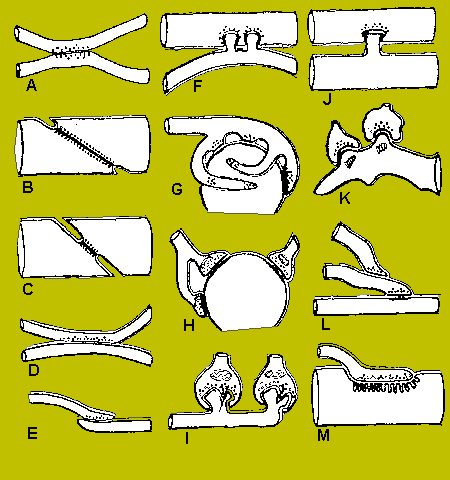
A. Coelenterate axon-axon example from jellyfish ganglion, with vesicles on both sides and without adhering sheath cells.
B. Earthworm septal synapse with close apposition of the membranes of the two cells and sparse vesicles on both sides.
C. Crustacean septal synapse, as in B except that the synaptic area is restricted.
Examples B and C have electrical transmission in either direction.
D. Axon-axon synapse en passant; typical of neuropile in many invertebrate ganglia, often with and often without sheaths.
E. Axon terminal arborization ending on a fine dendrite in an invertebrate neuropile.
F. Crustacean giant fibre to motoneuron synapse, with postsynaptic motor fibre invaginated into the giant fibre. This example also has electrical transmission, but only in one direction.
G. Axon arborization to soma (cell body) synapse typical of vertebrate brain cells.
H. Boutons terminaux of axon arborizations typical of central cell bodies in vertebrates.
I. Ribbon synapses between rod cell endings and dendrites of ganglion cells of vertebrate retina, with prsynaptic specialization.
J. Synapse between giant fibres of squid stellate gangIion, postsynaptic invaginated into presynaptic.
K. Spine synapse (axon-dendrite) from cerebral cortical dendrite of vertebrates with postsynaptic specialisation.
L. Serial synapse. Found in spinal cord, cerebral cortex, and plexiform layer of retina in vertebrates; offers many potentialities for presynaptic inhibition and other complex interacation in neuropliile.
M. Specialized neuromuscular endings found in vertebrate skeletal muscle, with postsynaptic grooves.